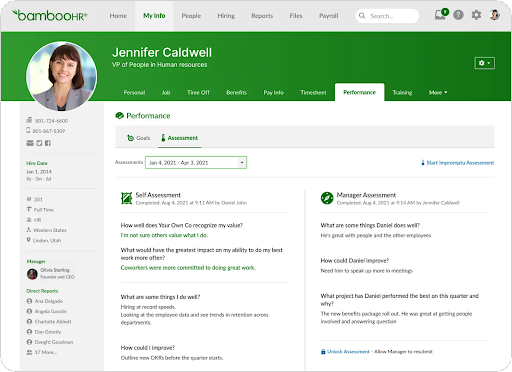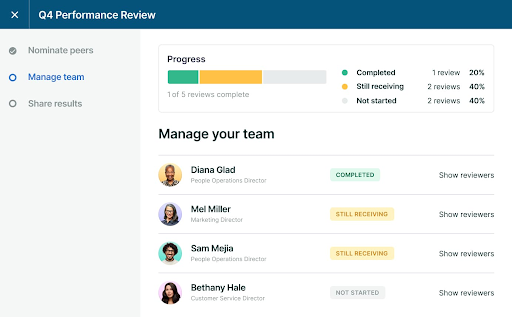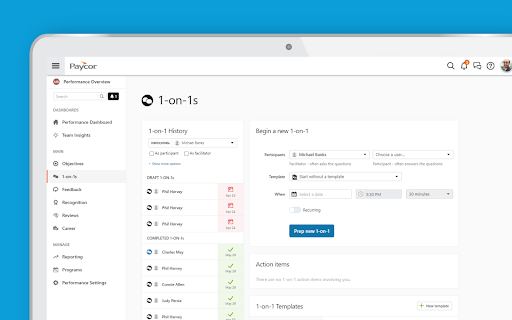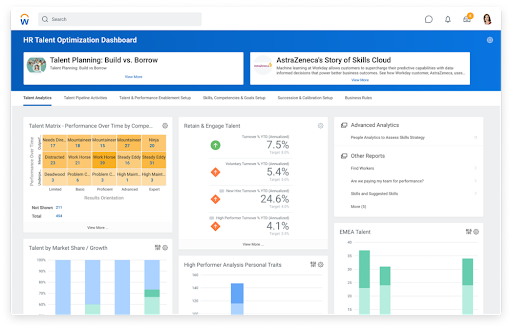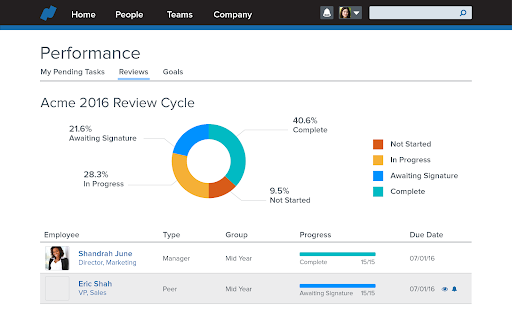Performance management systems: A guide for HR professionals looking to unlock workers’ potential
One in three employees view their workplace negatively owing to a lack of career growth opportunities.[1]
The inability to develop professional skills is the number one cause for employees to consider leaving their current jobs.
Part of the solution is using an employee performance management system to monitor and support employee skills development. It enables HR professionals to identify gaps and areas for upskilling, which is essential for better employee retention.
Performance management systems can help you develop an environment of continuous improvement and growth, leading to better business outcomes.
Another part of the solution is using talent assessments for personalized employee development.
In this article, we cover the benefits of performance management systems, review the best performance management systems, and share practices for using this HR technology.
Table of contents
- What is a performance management system?
- Why is an employee performance management system important to HR professionals?
- The benefits of performance management systems
- 5 best performance management systems
- 5 best practices for leveraging HR performance management systems in your HR department
- 3 examples of companies succeeding with performance management systems
- Use a performance management system to help your workforce achieve their goals and potential
- Performance management system FAQs
What is a performance management system?
A performance management system is an HR tool that monitors, evaluates, and improves employee performance, aligning individual performance goals with business objectives to identify the best employee development opportunities.
This HR technology usually relies on three key processes:
Goal alignment and management: This process aligns current employee performance, smart goals, and business objectives to increase employee engagement and satisfaction.
Performance feedback and monitoring: A performance management system provides timely feedback, employee recognition, and guidance for continuous skill development.
Performance evaluation: An HR performance management system enables accurate and consistent performance assessments, helping you evaluate your workforce’s contribution to the business.
Why is an employee performance management system important to HR professionals?
Performance management systems originated in the late 20th century and early 21st century when HR technology trends started emerging. These tools help with employee development, recognizing that ongoing skill enhancement is crucial for individual growth and organizational success.
A performance management system aligns employee motivation with organizational goals, creating a unified sense of purpose and driving collective efforts toward shared objectives.
These tools enable HR professionals to strategically improve employee performance, supporting organizational effectiveness, productivity, and adaptability.
In addition, performance management systems help HR teams create personalized career development plans that provide employees with a clear trajectory for growth and improvement, improving employee engagement and performance.
The best insights on HR and recruitment, delivered to your inbox.
Biweekly updates. No spam. Unsubscribe any time.
The benefits of performance management systems
Here’s how adopting excellent performance management systems can benefit your company.
1. Help bridge skills gaps
Skills gaps refer to the disconnect between employees’ competencies and the skills required for optimal company performance. These gaps arise owing to industry changes, technological advancements, generational shifts, and a lack of qualified candidates.
Around 87% of companies have or expect skills gaps in the near future.
A performance management system helps HR professionals identify skills gaps through continuous employee monitoring and assessments. It enables HR representatives to develop training initiatives and design employee coaching programs to bridge skills gaps effectively.
For example, a tech company can identify a lack of proficiency in a specific programming language crucial for an upcoming project. The organization uses this insight to create a training initiative for a software development team, helping motivated employees acquire new skills.
Performance management systems provide real-time feedback and guide skill development. As a result, employees become ready to tackle the project.
2. Improve employee development efforts
Managers often struggle to identify what motivates and engages their employees. In fact, 40% of managers say they lack the tools to uncover their employees’ motivations.
The solution is simple – offer your employees a clear path to progress their careers and reach their goals.
A way to do that is to combine a performance management system with regular 360-degree feedback to better understand your employees’ goals and motivations and provide them with personalized insights into improving their skills.
Adding a performance management system to your HR tech stack transforms one-sided performance evaluations into actionable plans.
Engagement and productivity soar when you align training initiatives with employees' goals. It motivates upskilling for your workforce, benefiting your company in the long run.
Many performance management system platforms integrate learning management systems, offering employees easy access to training materials, courses, and knowledge-sharing platforms.
This integration supports learning and encourages employees to explore new concepts and skills.
3. Establish a culture of continuous learning
Adopting performance management systems encourages regular performance discussions and goal adjustments, creating a culture where learning is a part of everyday operations and supports continuous improvement.
Regular employee feedback is a great way to discuss progress, challenges, and opportunities for improvement.
In addition, acknowledging employees who actively pursue continuous development creates a positive reinforcement loop, motivating others to engage in similar behaviors.
Almost half (40%) of American workers say they would put more effort into their work if recognized more often.[2]
Implementing employee recognition software can boost productivity and performance by 14%, and it’s one of the most essential non-financial metrics for employee satisfaction.[3]
By emphasizing development and improvement through a performance management system, businesses instill a growth mindset among employees. It creates a culture where workers view challenges as opportunities to learn and grow.
4. Increase employee retention
A performance management system helps create a personalized career growth plan for each employee. It provides them with a clear blueprint for development within the company, promoting a sense of purpose and loyalty.
According to research, employees with professional development opportunities are 34% more likely to stay with a company.[4]
Working on a clear professional development plan signals to your employees that you care about them and their goals. That way, they don’t feel like cogs in a machine but valuable team members who contribute to the organization's overall success.
Performance management systems help by supporting:
Goal alignment
A constructive feedback loop
Recognition and rewards
5 best performance management systems
Not all types of performance management systems on the market fit your organization’s needs.
That’s why we explored the best performance management system examples and collected five options to give you a much better idea of where to start.
Factors we considered
Choosing the right performance management system for your company requires carefully evaluating several critical factors.
Here’s a quick overview of key considerations to ensure the selection aligns with your organizational needs:
User-friendliness: An HR dashboard should be user-friendly to improve the adoption rates of a performance management system and ensure easier integration with your current practices.
Customization: A system that offers customization options can adapt to your company’s requirements more easily.
Integration: Easy integration with your existing HR tech stack promotes a unified and streamlined approach to talent management.
Scalability: Select a performance management platform that can accommodate your organization’s growth and changing dynamics.
Analytics and reporting: Systems with great analytics and reporting features support informed decision-making.
The top performance management systems: A summary
Tool | Performance management system benefits |
1. BambooHR | - Collaborative goal setting - Easy customization - Available free trial |
2. Lattice | - All-in-one HR tool - Easy communication and collaboration - Affordable and transparent pricing |
3. Paycor | - Easy integration with other HR tools - Streamlines payroll tasks - Available free trial |
4. Workday | - Excellent HR tech ecosystem - Supports continuous feedback - Available training programs and online resources |
5. Namely | - All-in-one HR tool - Payroll and benefits features - Easy customization |
1. BambooHR: Best overall
BambooHR is an all-in-one HR tool that enables easy employee performance management tracking.
This platform focuses on employee self-service, cultural alignment, and adjustable workflows that enable HR automation of the employee cycle. Individuals can actively participate in their performance management journey, from goal setting to feedback collection.
This effective performance management system promotes transparency in goal tracking, which helps employees and managers monitor progress collaboratively and make real-time adjustments.
It integrates candidate assessment software to ensure an individual aligns with the company's needs and objectives to go beyond traditional assessments.
Pros - Transparent goal tracking - Customization options - User-friendly interface - Multiple languages support - Free trial available
| Cons - Integration can be challenging - Somewhat limited advanced reporting features |
Rating: 4.5 out of five (G2)
Pricing at time of writing: Available on request
2. Lattice: Best for corporate teams
Lattice is a specialized people management system that helps HR professionals track employee engagement, performance, and goals.
This tool supports continuous feedback, real-time communication, and ongoing career development. The platform offers a comprehensive approach to performance reviews, incorporating 360-degree feedback and customizable review cycles.
Lattice contains useful features and integrates well with other HR systems by creating employee pulse surveys, scheduling one-on-one meetings, writing performance reviews, and organizing webinars.
Pros: - Easy to use - Affordable and transparent pricing - Many available add-ons - Great customer support | Cons: - Lack of customization - No free trial available |
Rating: 4.7 out of five (G2)
Pricing at time of writing: Starts at $8 per employee per month
3. Paycor: Best value for money
Paycor is a cloud-based platform primarily serving small to midsize businesses across different industries, offering a suite of HR and payroll software products.
Although the main focus is streamlining payroll tasks, Paycor’s performance management tools help set goals, conduct performance reviews, and track performance.
This platform is a great option if you’re looking for a comprehensive tool to handle most of your HR needs.
Pros - Useful HR features besides performance management - Integration with other HR tools - Mobile-friendly - Free trial available - Affordable pricing | Cons - The mobile app is not fully optimized - Lack of custom reporting options |
Rating: 4 out of five (G2)
Pricing at time of writing: Starts at $99 per month
4. Workday: Best for scaling businesses
Workday is a human capital management (HCM) platform designed to help HR professionals handle financial matters, talent management, the onboarding process, and workforce planning.
Workday offers various integration capabilities, great HR analytics software, and collaboration tools.
This tool is an excellent option for teams of all sizes, which is why it is perfect for companies looking to scale in the future.
Pros: - A versatile HR tool - Good for organizations of all sizes - Continuous feedback features - Available training programs and online resources | Cons: - It can be overwhelming at first - Limited report customization - No free trial available |
Rating: 4.3 out of five (G2)
Pricing at time of writing: Available on request
5. Namely: Best for small HR teams
Namely, a human resources information system (HRIS), is a great all-in-one tool for small to middle-sized businesses.
The platform features a user-friendly interface for managing various HR functions, including payroll, benefits administration, and talent management.
This HRIS system supports continuous performance feedback and annual reviews, promoting ongoing employee development and goal alignment.
It enables organizations to tailor performance management workflows to match their unique processes, ensuring flexibility.
Pros: - All-in-one HR tool - Payroll and benefits services - User-friendly interface - Available customization options - Mobile-friendly | Cons: - Occasional issues with customer support response times - Lack of pricing transparency - No free trial |
Rating: 3.9 out of five (G2)
Pricing at time of writing: Plans start at $9 per employee per month
5 best practices for leveraging HR performance management systems in your HR department
Performance management systems work best when combined with other HR tools and strategies.
In this section, we cover five best practices for maximizing the potential of performance management systems.
Best practices for using performance management systems: A summary
Best practice | What it achieves |
1. Adopt a culture of transparent feedback and continuous learning | Promotes communication channels, real-time feedback, and regular check-ins, creating a culture of continuous learning and development |
2. Determine goals that align with employee and organizational needs | Supports collaborative goal-setting based on goals and insights, improving engagement and productivity |
3. Monitor employee growth after feedback with talent assessments | Creates a feedback loop, helping adjust training approaches and supporting personalized development tracking |
4. Leverage insights to provide prompt, accurate recognition and feedback | Supports prompt recognition and feedback to ensure your employees stay motivated and focused on professional development |
5. Determine where you stand, what you hope to accomplish, what's working with your current system, and what isn't | Enables a strategic approach that defines objectives, identifies steps for success, and creates a clear action plan |
1. Adopt a culture of transparent feedback and continuous learning
A performance management system helps create a culture of feedback by providing transparent channels of communication. You can use your performance management process to improve your feedback channels by:
Implementing regular performance reviews
Encouraging open communication between employees and managers
Using the feedback features in your performance management system to facilitate real-time comments and evaluations
Listening to input from peers and subordinates
Incorporating 360-degree feedback in the workplace
A performance management system can catalyze continuous learning and development in your organization.
To do that, you must set clear, measurable goals within the performance management system, use talent assessments to identify skills gaps, and encourage employees to create personalized development plans based on performance insights.
Some systems have adopted AI to improve HR features, such as getting customized learning recommendations based on individual employee performance data. AI in HR is likely to become more common, so you should explore your options.
2. Determine goals that align with employee and organizational needs
According to the latest data, 48% of companies using a performance management system do it to improve productivity and engagement.
By comparison, only 31% focus on employee skill development.[5]
When you provide targeted employee skill development opportunities, engagement and productivity benefits follow.
Here’s how you can align employee and organizational goals to support employee development:
Initiate collaborative goal-setting sessions where employees and managers discuss and define measurable objectives
Use goal-setting features to document and track individual and team goals
Incorporate skills-based assessments within the performance management software to identify specific competencies that align with organizational needs
Use performance management system analytics to identify emerging skills gaps and align future goals
3. Monitor employee growth after feedback with talent assessments
Once you’ve created personalized development plans for your employees, you can track progress with talent assessments.
These tests provide data about your employees’ strengths, weaknesses, and growth potential. Because you receive quantifiable results, you can compare the data to measure employee development.
Integrating talent assessments with your performance management system creates an ongoing feedback loop that enables you to adjust employee training programs for the best results.
For example, if an employee in your sales department needs to improve their negotiating skills, you can create a development plan within the performance management system, setting goals to enhance negotiation techniques.
You then use the Retail Sales test to evaluate the employee’s progress. Thanks to the integration with the performance management system, you can track the effectiveness of the development plan in real time.
The analytics help you identify further areas for improvement and adjust the coaching program accordingly.
4. Leverage insights to provide recognition and feedback
A performance management system provides valuable insights into employees’ achievements and progress. You can use real-time analytics to promptly identify and acknowledge outstanding performance.
The important thing about feedback and recognition is that it is timely and accurate. That way, your employees can gain the most benefits.
You can ensure timely recognition by setting recognition programs within the performance management system triggered by specific achievements or milestones.
Some performance management systems offer an option to create personalized recognition programs based on individual preferences and motivations. You can use this feature to improve employee engagement and motivation.
5. Determine where you stand, what you hope to accomplish, what’s working with your current system, and what isn’t
Before optimizing your performance management system, you must comprehensively assess your current business standing, needs, and goals.
By defining clear objectives, identifying successful elements, and determining areas for improvement, you ensure a strategic approach to system improvement.
Here’s how you can complete this comprehensive assessment:
Conduct a current state analysis: Have performance conversations and ask for feedback on your current performance management system to identify pain points, bottlenecks, and gaps between its capabilities and user expectations.
Define clear objectives: Collaborate with key stakeholders to define specific, measurable, and achievable objectives for performance improvement and your performance management solution.
Identify the positives: Analyze components of your existing performance management system that have proven successful and replicate or expand upon them.
Create an action plan: Develop a comprehensive blueprint outlining specific steps and timelines and responsible people for implementing improvements. Communicate the methodologies and plans across the organization.
3 examples of companies succeeding with performance management systems
Many companies use performance management systems to keep their workforce engaged and focused on growth.
Let’s look at three success stories of companies using performance management systems to support employee development and standardize the performance review process.
Muck Rack
Community Counseling Center
One Login
Muck Rack
Muck Rack, a public relations management platform for journalists, has grown from 75 to more than 250 employees in just three years.
This rapid growth uncovered the need for standardized and scalable HR practices. The organization needed more consistency in continuous performance management, promotions, compensation adjustments, and employee feedback.
That’s why the company partnered with Lattice to implement a performance management system with engagement surveys, performance reviews, and employee development tools.
As a result, the company:
Experienced a 100% performance appraisal completion rate
Simplified the HR tech stack into an all-in-one platform
Saw high adoption rates thanks to Slack integration
Created an action plan to offer more opportunities for career development and strategic initiatives[6]
Community Counseling Center
Community Counseling Center, a mental health organization with 440 employees operating across five counties, faced challenges in managing performance assessments efficiently and meaningfully.
The main problem was time-consuming and ineffective performance assessments. The old system involved a lengthy review process, focusing heavily on the percentage of salary raises instead of employee growth and development.
The process took up to three hours per cycle, with significant time spent on documentation.
Partnering with BambooHR helped the organization reduce assessment time and refocus on employee growth.
A well-prepared launch, training materials, and effective communication ensured a successful transition.
Here are the results of using this performance management system:
Reduced performance assessment time from three hours to about an hour
Refocused on employee development
Identified barriers to growth and performance
Enabled transparent conversations between employees and supervisors[7]
OneLogin
OneLogin, a technology company based in San Francisco, specializes in providing single sign-on and cloud identity management services.
With a workforce of around 200 employees, the company faced challenges in HR management, particularly concerning the limitations of its existing professional employer organization (PEO) system.
The organization switched to Namely, gaining independence from the PEO and unlocking numerous benefits.
It established a performance management system with a structured approach to self-reviews, 360 reviews, and traditional manager-employee reviews.
This implementation helped:
Instill a culture of continuous feedback
Increase employee engagement and satisfaction
Improve data management and reporting
Reduce the time spent on manual HR tasks[8]
Use a performance management system to help your workforce achieve their goals and potential
Performance management systems help businesses bridge skills gaps, support employee development, and increase retention rates.
By selecting one of the five performance management systems we explored, adopting a culture of transparent feedback, aligning employee and strategic goals, and monitoring employee growth, you can unlock the full potential of your workforce.
If you want to make your workers feel valued and supported, learn more about improving their employee experience with employee experience software.
Are you interested in how TestGorilla’s talent assessments can support your performance management system?
Watch a live demo or create a free account to find out how skills assessments can supercharge your employees’ skill sets!
Performance management system FAQs
Have more questions about performance management systems? Find your answers below.
What are the 5 elements of a performance management system?
The five elements of a performance management system are:
Planning: aligning personal goals with organizational objectives
Monitoring: using feedback and goal-tracking
Developing: promoting continuous learning
Rating: performing systematic performance evaluations and continuous performance management
Rewarding: using timely recognition and celebrating achievements
What is an example of a performance monitoring system?
BambooHR is an excellent performance management system example. This platform facilitates goal tracking, transparent performance assessments, and employee self-service.
It streamlines performance management, emphasizing engagement, culture alignment, and real-time progress monitoring. Customizable workflows ensure employees actively participate in the development journey.
How do you monitor employee performance?
Efficient employee performance monitoring involves:
Establishing clear, measurable goals
Providing continuous constructive feedback
Conducting regular performance reviews
Using advanced performance management systems
Tools like BambooHR, Namely, and Lattice offer real-time insights and in-depth analytics and support proactive decision-making, ongoing individual improvement, and organizational success.
Sources
Palmeri Farris, Shelby. (June 27, 2022). “2022 Toxic Work Environment Report”. CareerPlug. Retrieved January 24, 2024. https://www.careerplug.com/blog/toxic-work-environment/
Novak, David. (May 9, 2016). “Recognizing Employees Is the Simplest Way to Improve Morale”. Harvard Business Review. Retrieved January 24, 2024. https://hbr.org/2016/05/recognizing-employees-is-the-simplest-way-to-improve-morale
Daunt, Valarie; Menzies, Vicky. (January 2, 2014). “Recognition programmes – Are they important?”. Deloitte. Retrieved January 24, 2024. https://www2.deloitte.com/ie/en/pages/deloitte-private/articles/recognition-programmes.html
“The Impact of Professional Development”. (June 30, 2016). Better Buys. Retrieved January 24, 2024. https://www.betterbuys.com/lms/professional-development-impact/
Gallimore, Nick. (2022). “Performance Management Report 2022”. Clear Reviewer. Retrieved January 24, 2024. https://cdn-web.clearreview.com/media/Performance-Management-Report-2022-1.pdf
“How Muck Rack Drives Engagement, Performance, and Development With Lattice”. (May 29, 2023). Lattice. Retrieved January 24, 2024. https://lattice.com/customers/muck-rack
“Case Study | Community Counseling Center”. (September 8, 2022). BambooHR. Retrieved January 24, 2024. https://www.bamboohr.com/customers/community-counseling-center
“How OneLogin Went from Outsourcing HR to Becoming a Best Place to Work”. Namely. Retrieved January 24, 2024. https://namely.com/clients/onelogin/
You've scrolled this far
Why not try TestGorilla for free, and see what happens when you put skills first.


